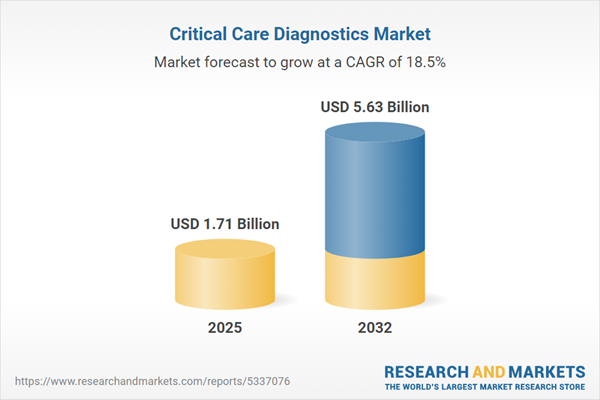Speak directly to the analyst to clarify any post sales queries you may have.
Critical care diagnostics is shaping a new standard in clinical environments, offering hospital leaders pathways to faster, evidence-based decision-making. Seamless technology integration is now central to advancing patient care quality and strengthening institutional resilience against evolving healthcare challenges.
Market Snapshot: Critical Care Diagnostics Market
The global critical care diagnostics market stands at USD 1.45 billion in 2024 and is forecast to reach USD 1.71 billion in 2025. Sustained momentum is projected through 2032, with industry valuation anticipated at USD 5.63 billion, reflecting a robust compound annual growth rate (CAGR) of 18.47%. The adoption of advanced diagnostic platforms and analytic tools is modernizing healthcare delivery. As organizations bridge laboratory and point-of-care operations, medical teams are supported in providing timely and precise interventions. This evolving landscape is strongly influenced by regional regulatory pressures, emerging care models, and ongoing technological innovations, resulting in rapidly shifting procurement and adoption strategies across global markets.
Scope & Segmentation of the Critical Care Diagnostics Market
This analysis provides senior leaders with comprehensive segmentation to inform market entry, investment, and operational decisions. Each area reflects core aspects of the market’s evolving structure and practical dynamics in both established and emerging care environments:
- Product Types: Benchtop analyzers, portable analyzers, diagnostic kits with integrated quality controls, specialty reagents, advanced software platforms, and packaged full-service solutions are available to fit a range of institutional and clinical requirements.
- Applications: Core segments include blood gas and electrolyte testing, detection of cardiac markers, coagulation monitoring, infectious disease assays, and evaluations for metabolic disturbances—collectively supporting rapid, multi-faceted diagnostic needs in urgent and routine scenarios.
- Technologies: Central laboratory instrumentation, point-of-care solutions, and bedside testing enable immediate diagnostic access, supporting faster clinical decisions in acute episodes.
- End Users: Hospital laboratories, ambulatory care centers, and reference laboratories each prioritize unique integration and technology deployment needs, reflecting diverse patient populations and operational expectations.
- Test Modes: Integrated workflows across laboratory and acute-care environments promote greater efficiency and responsiveness, especially during high-acuity clinical events.
- Regions: The Americas, Europe, Middle East and Africa, and Asia-Pacific markets are characterized by varied regulatory structures and distinct adoption cycles, guiding region-tailored procurement and deployment strategies.
- Companies Covered: Market leadership is represented by F. Hoffmann-La Roche AG, Abbott Laboratories, Siemens Healthineers AG, Danaher Corporation, Thermo Fisher Scientific Inc., Sysmex Corporation, bioMérieux SA, Becton, Dickinson and Company, Ortho Clinical Diagnostics, Inc., and Werfen Group.
Key Takeaways for Senior Decision-Makers in the Critical Care Diagnostics Market
- Broad integration of diagnostic data empowers teams to optimize care delivery and orchestrate prompt responses in critical settings.
- Standardized clinical protocols and workflow management support flexible resource allocation, aligning care models with shifting operational priorities.
- Diagnostic solution adaptability, provided through modular kits and specialized reagents, gives clinicians latitude to address both everyday and complex clinical demands.
- Proactive supplier engagement and logistics planning help organizations stabilize operations and sustain supply chains during regulatory or market disruptions.
- Collaboration between solution vendors and clinical staff accelerates the adoption of new testing capabilities, facilitating decentralized care models and continuous workflow improvements.
Impact of United States Tariff Changes
Recent tariff changes in the United States have led healthcare systems to revisit sourcing and procurement approaches for critical care diagnostics. Increasing reliance on domestic vendors, enhanced local inventories, and longer-term agreements are driving improved supply transparency, higher vendor accountability, and greater business continuity even in volatile regulatory landscapes.
Research Methodology & Data Sources
Findings in this analysis are grounded in executive interviews with healthcare leaders, laboratory managers, and procurement specialists. All insights are cross-referenced with peer-reviewed studies, regulatory documentation, and proprietary market intelligence to ensure a valid, real-world perspective that reflects actual practices and industry benchmarks.
Why This Report Matters for Executive Teams
- Empowers decision-makers to select diagnostic technologies that align precisely with organizational care priorities, operational structures, and compliance requirements.
- Provides actionable segmentation, enabling more effective procurement, vendor evaluation, and competitive positioning across global markets.
- Supports the development of robust risk and compliance strategies that protect institutional consistency in an unpredictable regulatory environment.
Conclusion
Leveraging targeted investments in diagnostic technology and fostering strong industry partnerships place organizations in a position to deliver reliable, agile care. Such strategic direction helps institutions adapt and remain resilient amid continuous change in healthcare delivery.
Additional Product Information:
- Purchase of this report includes 1 year online access with quarterly updates.
- This report can be updated on request. Please contact our Customer Experience team using the Ask a Question widget on our website.
Table of Contents
3. Executive Summary
4. Market Overview
7. Cumulative Impact of Artificial Intelligence 2025
Companies Mentioned
The companies profiled in this Critical Care Diagnostics market report include:- F. Hoffmann-La Roche AG
- Abbott Laboratories
- Siemens Healthineers AG
- Danaher Corporation
- Thermo Fisher Scientific Inc.
- Sysmex Corporation
- bioMérieux SA
- Becton, Dickinson and Company
- Ortho Clinical Diagnostics, Inc.
- Werfen Group
Table Information
| Report Attribute | Details |
|---|---|
| No. of Pages | 188 |
| Published | November 2025 |
| Forecast Period | 2025 - 2032 |
| Estimated Market Value ( USD | $ 1.71 Billion |
| Forecasted Market Value ( USD | $ 5.63 Billion |
| Compound Annual Growth Rate | 18.4% |
| Regions Covered | Global |
| No. of Companies Mentioned | 11 |









